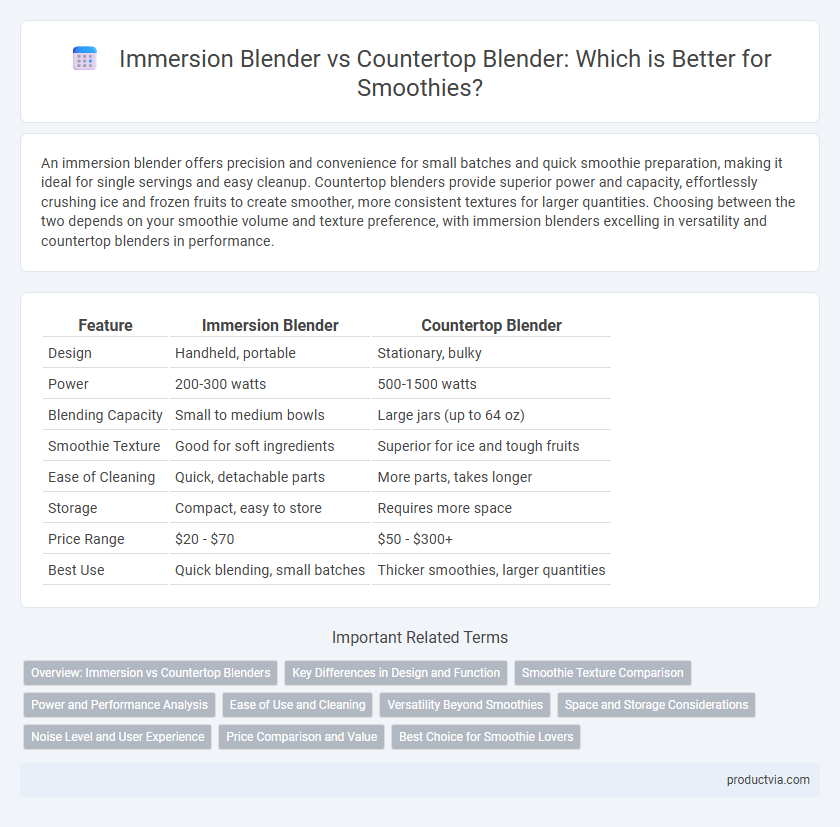An immersion blender offers precision and convenience for small batches and quick smoothie preparation, making it ideal for single servings and easy cleanup. Countertop blenders provide superior power and capacity, effortlessly crushing ice and frozen fruits to create smoother, more consistent textures for larger quantities. Choosing between the two depends on your smoothie volume and texture preference, with immersion blenders excelling in versatility and countertop blenders in performance.
Table of Comparison
| Feature | Immersion Blender | Countertop Blender |
|---|---|---|
| Design | Handheld, portable | Stationary, bulky |
| Power | 200-300 watts | 500-1500 watts |
| Blending Capacity | Small to medium bowls | Large jars (up to 64 oz) |
| Smoothie Texture | Good for soft ingredients | Superior for ice and tough fruits |
| Ease of Cleaning | Quick, detachable parts | More parts, takes longer |
| Storage | Compact, easy to store | Requires more space |
| Price Range | $20 - $70 | $50 - $300+ |
| Best Use | Quick blending, small batches | Thicker smoothies, larger quantities |
Overview: Immersion vs Countertop Blenders
Immersion blenders feature a handheld design with a rotating blade at the end, ideal for blending directly in containers and offering greater control for small batches of smoothies. Countertop blenders provide powerful motors and larger capacity jars, making them suitable for quickly processing larger quantities and handling tougher ingredients like frozen fruits and ice. Selecting between the two depends on whether convenience and portability or power and volume are prioritized for smoothie preparation.
Key Differences in Design and Function
Immersion blenders feature a handheld design with a long shaft and detachable blade, making them ideal for blending directly in containers, while countertop blenders have a fixed base with a large pitcher suited for processing larger quantities. The motor power in countertop blenders generally surpasses that of immersion blenders, facilitating smoother and faster blending for dense ingredients like frozen fruits and ice. Countertop blenders also offer variable speed settings and preset programs, providing greater versatility compared to the simpler, on/off functionality typical of immersion blenders.
Smoothie Texture Comparison
Immersion blenders create smoothies with a slightly chunkier texture due to their handheld design and slower blending speed, which is ideal for retaining some pulp and fiber. Countertop blenders produce smoother, more consistent textures by using powerful motors and sharp blades that thoroughly pulverize frozen fruits and vegetables. For creamy, velvety smoothies, countertop blenders outperform immersion blenders with their high RPM settings and larger blending jars.
Power and Performance Analysis
Immersion blenders typically feature motors ranging from 200 to 400 watts, providing sufficient power for blending smoothies directly in a cup or bowl with ease and control. Countertop blenders boast more robust motors, often between 500 and 1500 watts, delivering higher torque for smoother textures and efficient crushing of ice and frozen fruits. For smoothie enthusiasts seeking maximum blending performance and consistency, countertop blenders generally outperform immersion blenders due to their superior power and blade design.
Ease of Use and Cleaning
Immersion blenders offer superior ease of use and cleaning for smoothie preparation due to their lightweight design and detachable blending wand, which allows for quick disassembly and rinsing directly in the container. Countertop blenders, while powerful, often involve multiple parts including a heavy jar, lid, and blade assembly, requiring more time and effort to clean thoroughly. For users prioritizing convenience and minimal cleanup, immersion blenders provide a streamlined experience ideal for daily smoothie making.
Versatility Beyond Smoothies
Immersion blenders excel in versatility beyond smoothies by effortlessly blending soups, sauces, and dressings directly in the pot, reducing cleanup time. Countertop blenders offer powerful motors and larger capacities ideal for crushing ice, making nut butters, and creating creamy frozen desserts. Both appliances serve distinct functions, with immersion blenders prioritizing convenience and countertop blenders delivering high-performance blending for diverse culinary tasks.
Space and Storage Considerations
Immersion blenders occupy minimal counter space and are easy to store in drawers or cabinets, making them ideal for compact kitchens. Countertop blenders require dedicated space on the counter due to their larger base and pitcher, which may limit available workspace. Choosing an immersion blender enhances kitchen efficiency by combining portability with convenient storage options.
Noise Level and User Experience
Immersion blenders produce significantly less noise compared to countertop blenders, making them ideal for quieter smoothie preparation. Their compact design offers greater control and ease of use, allowing users to blend directly in the fruits or containers without transfers. Countertop blenders can be louder and bulkier but deliver more power for smoother consistency and larger batch sizes.
Price Comparison and Value
Immersion blenders typically cost between $20 and $100, offering affordable and compact options perfect for single servings and quick smoothie blends. Countertop blenders range from $50 to over $500, with higher-priced models providing powerful motors and versatile features that enhance smoothie texture and nutritional extraction. For budget-conscious buyers, immersion blenders provide excellent value for simple smoothies, while countertop blenders deliver better performance and durability for frequent or larger-batch smoothie preparation.
Best Choice for Smoothie Lovers
Immersion blenders offer precise control and easy cleanup, making them ideal for small, single-serving smoothies with minimal prep. Countertop blenders deliver powerful motors and larger capacities, perfect for creating thick, creamy smoothies from frozen fruits and bulky ingredients. For smoothie lovers seeking speed and versatility, countertop blenders are generally the best choice, while immersion blenders excel in convenience and portability.
Immersion blender vs Countertop blender for smoothies Infographic

 productvia.com
productvia.com